Whether you’re headed to the park or the pool, protecting your baby from the sun’s rays is a hot-button priority, to say the least.
Though you can protect babies and toddlers with the best baby swimsuits and UPF rash guards on the market, you can’t compare apparel to direct-on-skin lotions.
That’s why the New York Post turned to two board-certified dermatologists to hand-pick the best baby sunscreens on the market (and, to give us the 411 on how to apply and what to know before you do).
The American Academy of Dermatology (AAD) recommends that before six months of age the best course of sun protection is sun avoidance and shade. But, once your baby is halfway to the one-year-old mark, you should choose from one of the below options.
Related: Best spray sunscreens
“Most sunscreen formulations for children are physical, meaning they use titanium or zinc as the active ingredients,” Brendan Camp, MD, NYC-based double board-certified dermatologist at MDCS Dermatology, told The Post. “This is because physical sunscreens tend to be less irritating. Aside from that, baby sunscreens differ from adult sunscreens primarily only in packaging and marketing.”
Ahead, find the best baby sunscreens to stock up on. Alongside our expert-backed product picks, we also curated an in-depth FAQ section to answer your questions on shopping for and applying baby sunscreen.
For more, check out our expert-backed SPF guides on the best mineral sunscreens and best sunscreens for melanated skin — that won’t leave a white cast.
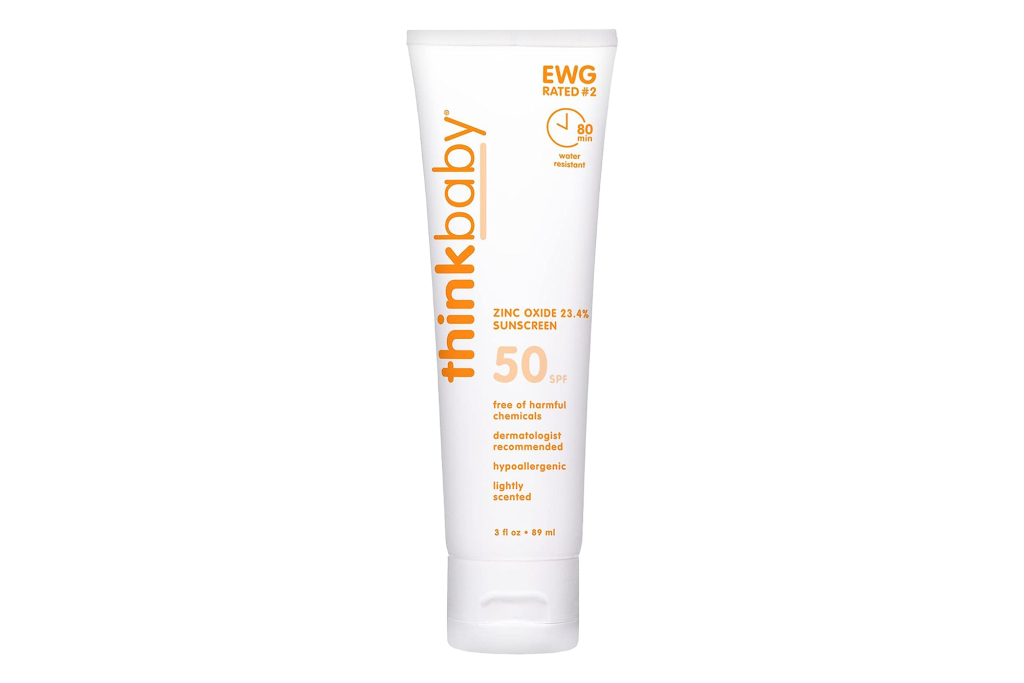
Pros:
- Non-nano zinc oxide
- Water-resistant for 80 minutes
- High SPF protection as well as hydrating ingredients
- Larger supply
Cons:
- The cream is thick and bright which can get messy
Size: 6 ounces
“My personal favorite sunscreen to use on my babies is the Thinkbaby SPF 50+ Baby Sunscreen,” said Shereene Idriss, MD, double board-certified dermatologist in NYC — who specializes in cosmetic dermatology. “It’s formulated with non-nano zinc oxide for full spectrum UVA and UVB protection. It’s also water resistant up to 80 minutes and pediatric dermatologist-recommended.”
Camp also recommends this formulation, as it not only offers SPF 50 protection but “also features hydrating ingredients like sunflower oil, jojoba oil, olive oil and hyaluronic acid.”
Customers are saying: “It’s a thick white cream and a tiny bit goes a long way. I can use a dollop smaller than a dime and cover his arms, legs, and face. It is a white cream that is opaque at first, but rubs in and doesn’t show. It smells wonderful like vanilla and orange, so it’s not like that annoying sunscreen smell. We love it for our baby.”
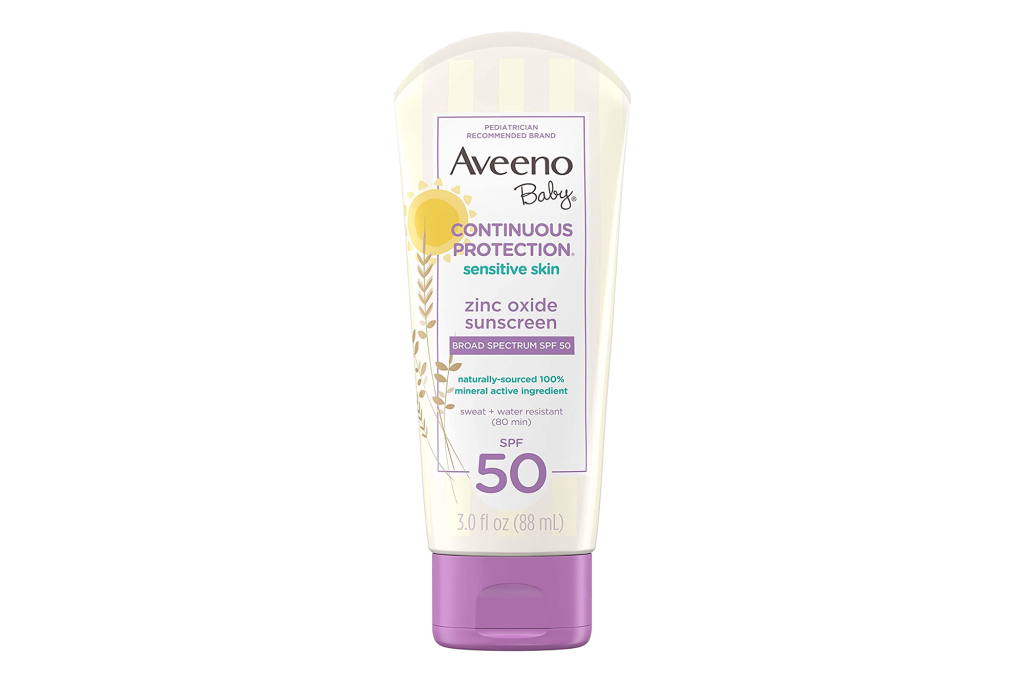
Pros:
- Fragrance-free
- High SPF protection
- Ideal for sensitive skin
Cons:
- It can be difficult to spread on the skin (paste consistency per review)
Size: 3 ounces
“Formulated for sensitive skin, this SPF 50 lotion is also free of parabens, phthalates, and fragrance,” Camp noted.
Even better, it’s from a trusted brand, apt for sensitive skin, and is both sweat and water-resistant for up to 80 minutes before you’ll have to reapply.
Customers are saying: “No burns here. This is our favorite sunscreen for our babies. It goes on thick and love that it is white but then clears up. It makes it easy for me to see where I missed any spots.”

Pros:
- Plant-based formula
- Parents say it does not sting the eyes
- High SPF protection
- Stick formula glides easy
Cons:
- The stick can get very dry if the lid is not properly closed
Size: 13 grams
Who doesn’t love an easy-to-apply stick sunscreen? Though you’ll have to be extra careful about not missing a spot, the Sun Bum Fragrance-Free Mineral SPF 50 Sunscreen Face Stick offers versatile sun protection.
“As an SPF 50 mineral-based product, this sunscreen glides on easily and is great for use on the face, lips, ears and nose,” Camp highlighted.
Another check in its favor? It’s a 100% mineral sunscreen that offers broad-spectrum protection. “It’s formulated with shea butter and coconut oil which helps to moisturize and protect the skin,” Dr. Idriss noted, along with recommending the product.
Customers are saying: “This is the perfect sunscreen to keep in your bag for on the go. It rolls on easily and rubs in well. Great coverage and great for young kids’ sensitive skin.”

Pros:
- Completely mineral based
- High SPF protection
- Bottle changes color in the sun
- It comes with a larger supply than some others
Cons:
- Some reviewers mentioned the product was not entirely sealed
Size: 5 ounces
“Zinc and titanium are featured in this mineral-based product that comes in a smart bottle that turns pink when exposed to UV rays to remind you that it’s time to apply sunscreen,” Camp noted, recommending the Blue Lizard Baby Mineral Sunscreen SPF 50+.
With 7,000+ applauding reviews on Amazon, this particular formulation is also fragrance-free and water-resistant for up to 80 minutes before you’ll need to reapply on your baby.
Customers are saying: “This brand has quickly become a favorite in our house. I used to think it was too expensive, but now I realize it is worth it. Goes on smoothly, it isn’t greasy and smells good. I even use the baby stuff as a fair-skinned momma! “
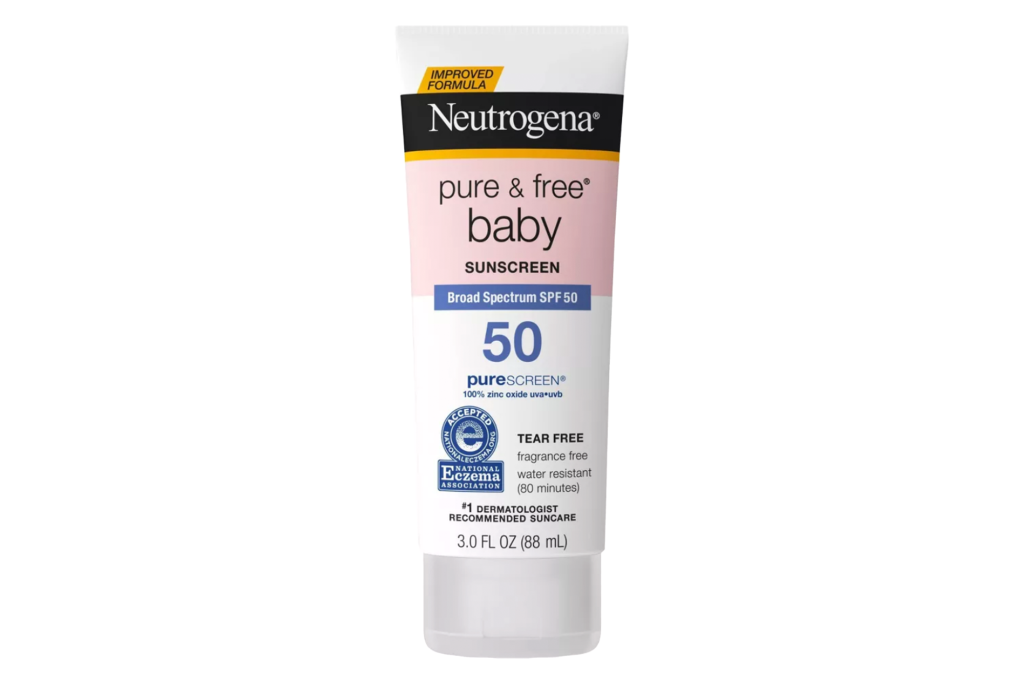
Pros:
- Water-resistant for 80 minutes
- Fragrance-free
- The formula is less thick than some others (per reviews)
Cons:
- It can cause some skin dryness (per reviews)
Size: 3 ounces
“Offering SPF 50 protection with mineral coverage, this sunscreen is free of fragrance, parabens, phthalates and dyes, making it ideal for sensitive skin,” Camp said.
Though it’s not widely available to order online, it’s just shy of $15 at Target and has been approved by the National Eczema Association — even more ideal for babies who may be experiencing eczema or textured skin in general.
Customers are saying: “This brand was recommended by my pediatrician. I first used it when my baby was 6 months old and we went to the beach. It was not too thick or greasy and rubbed on well. It gave good coverage and my kid did not get sunburned.”

Pros:
- Includes seed oil and shea butter for skin softness
- Mineral-based formula
Cons:
- The tube can be hard to squeeze (per some reviews)
- Nice smell (per reviews)
Yes, Supergoop! has a glamorous sunscreen lotion made perfectly for babies and kids (and, is just as elegant as its top-rated Glowscreen Body SPF 40 ($42) — for the adults, anyway.
“This mineral sunscreen provides SPF 50 protection and contains sunflower seed oil and shea butter to hydrate and nourish skin,” Camp pointed out.
Size: 3 ounces
Customers are saying: “Use on my kids every day! It is thick but rubs in nicely. I’m not the best at reapplying sunscreen throughout the day but I have never once had a burnt kid after using the mineral lotion.”
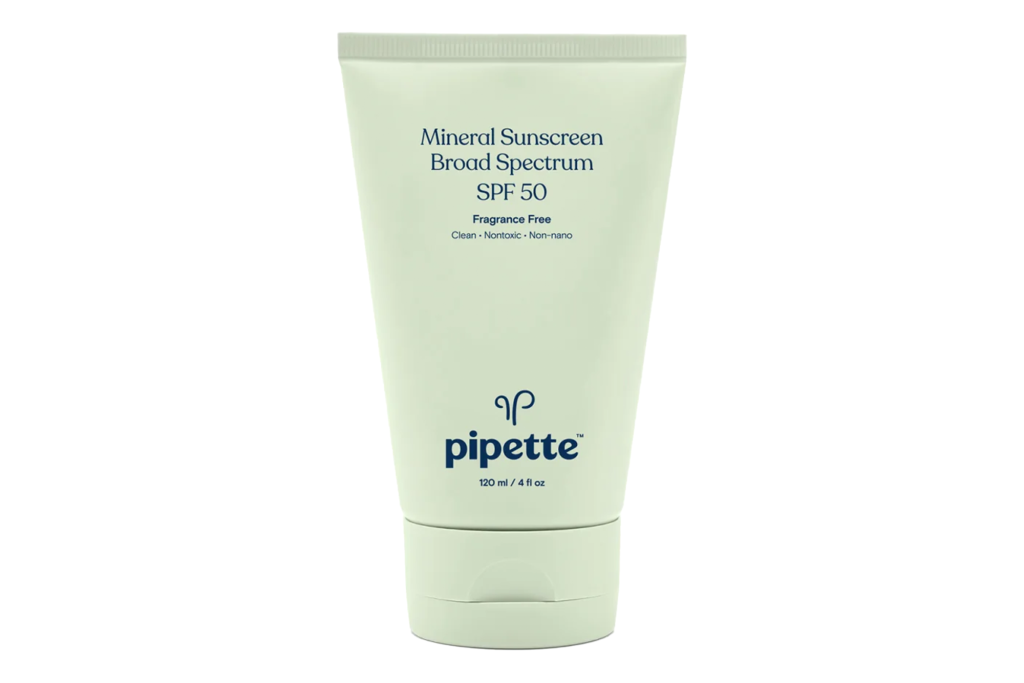
Pros:
- More sheer than some other formulas
- Completely fragrance-free
- Moisturizing effect
Cons:
- Can be difficult to find in stores
Size: 4 ounces
“Appropriate for use by the whole family, this SPF 50 product contains squalane to provide sheer, moisturizing coverage,” Camp said.
Not to mention, Pipette is a trusted brand for all things baby — from its Baby Shampoo + Wash ($9) to the After-Sun Gel ($11), the latter you’ll want to pick up along with your sunscreen.
Customers are saying: “This is my favorite sunscreen! I live it and use it in my kids every day. They are picky about smell and feel and this is the only sunscreen they don’t complain about.”

Pros:
- Spreads easily on the skin
- Unscented
- Glycerin and antioxidants for hydrating
Cons:
- Some people experienced stinging when sunscreen was placed near the eyes
Size: 6.7 ounces
“If you’re looking for a sunscreen without a white cast, La Roche-Posay Anthelios Kids Gentle Lotion Sunscreen SPF 50 is a nice gentle formulation,” Idriss recommended. “It has broad spectrum UVA/UVB protection, plus antioxidants.”
Plus, it’s widely available to order online and, though a splurge, it’s fragrance-free, water-resistant for up to 80 minutes and is suitable for the face and body.
Customers are saying: “I get a skin rash when I’m out in the sun and most sunscreens don’t help protect my skin from getting that rash. This stuff works amazingly well. I only need to put a small drop of it on my arms in the morning, and it protects me all day!!
Post Wanted Picks
Best for eczema: TruKid Eczema Daily Sunscreen

Pros:
- Good combination of ingredients for healing
- Spreads easily and is less thick than some others
- Lovely citrus scent
Cons:
- Lower SPF (better on overcast days)
Size: 3.4 ounces
For a solid daily sunscreen, I’ve used the TruKid Eczema Daily Sunscreen on my one-year-old. My daughter inherited my very sensitive skin, so I wanted to find something very clean and gentle (as well as tested on many babies with eczema). I love that this formula incorporated aloe vera, to help soothe the skin as well as jojoba oil to aid in any burn healing. Her skin has never had a bad reaction. The SPF count is slightly lower, but we use this on overcast days where the sun could be sneaky. It smells lovely as well — like citrus.
Customers are saying: “This is my favorite sunscreen. It works at least as good/if not better as any others I’ve tried, nice orange-like scent, not oily, not excessively thick, and effectiveness is immediate — added bonus the company uses biodegradable packing noodles…”
Best drugstore: CeraVe Baby Sunscreen SPF 45
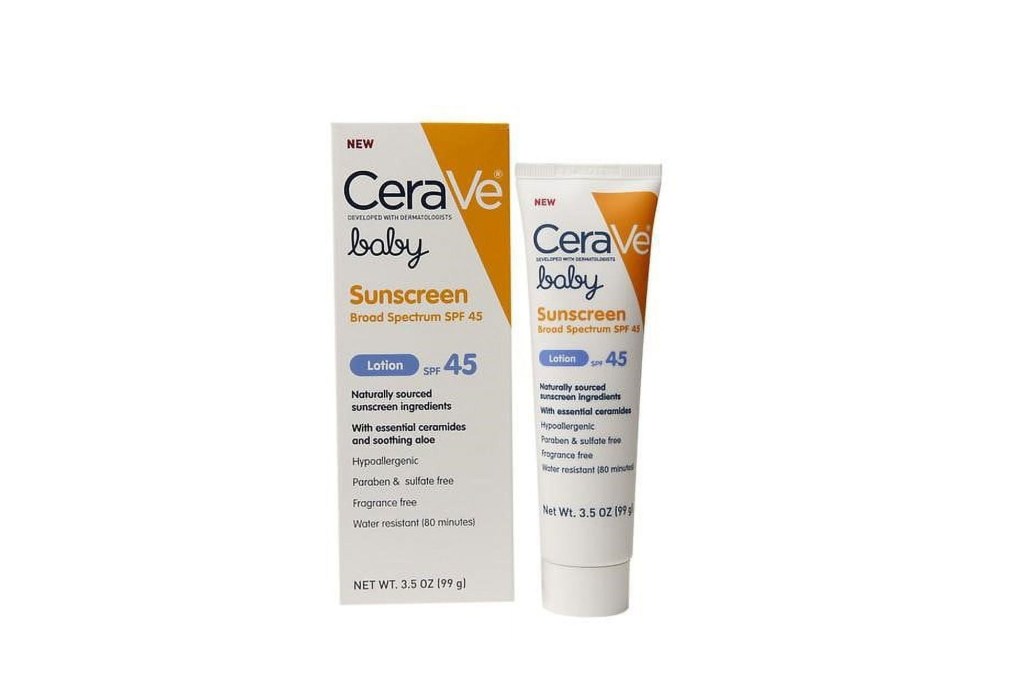
Pros:
- Fragrance-free
- Takes about five minutes to absorb into the skin
- Water-resistant for 80 minutes
Cons:
- Lower SPF than some other formulas
Size: 3.5 ounces
I’ve seen this sunscreen in a few drugstores and purchased it while traveling when I needed something on the fly. It exceeded all my expectations. It might not have the fresh smell of some scented options, but the paste spreads very easily, absorbs into the skin, and it seems to stay on for well over an hour. I wish it was a bit easier to find online, but you can scoop it up at Walmart for just $19.99.
Customers are saying: “I think this sunscreen is perfect for the little kiddos. The white, pasty substance lasts on the skin for a long time, even in contact with water. It protected my son’s skin for hours while playing on his splash pad.”
An FAQ on Baby Sunscreens
Ahead, our team of board-certified dermatologists best explains what to know before buying a newly minted baby sunscreen (and, just as important, how to properly apply it).
What age can babies start wearing sunscreen?
As mentioned, the American Academy of Dermatology (AAD) recommends that before six months of age the best course of sun protection is sun avoidance and shade.
“In the first six months for newborns, you should generally avoid direct exposure to the sun and sunscreen use as their skin is highly sensitive and more prone to irritation from sunscreen ingredients,” Idriss added.
How does baby sunscreen differ from adult sunscreen?
Baby sunscreen typically contains milder and gentler ingredients to minimize the risk of skin irritation.
“For example, zinc oxide which has soothing properties that can help calm irritated skin and reduce redness and inflammation,” Idriss explained. “It’s often also used in diaper creams to protect and soothe the baby’s delicate skin.”
For the most part, baby sunscreens will also be fragrance-free and hypoallergenic, the latter helping to prevent allergic reactions.
What SPF level is best for babies?
Once your baby is at least six months old, a general rule of thumb — according to Idriss — is to select a broad-spectrum sunscreen with an SPF of at least 30. This remains on par with dermatologists’ recommendations for kids and adults, too.
For a sunscreen to be “broad-spectrum,” it means that the formulation itself will help protect against both UVA and UVB radiation. UVA typically refers to rays that, if exposed too heavily on the skin, have a more direct (and negative) effect on anti-aging. UVB, because its rays are shorter than those of UVA, is more associated with skin burning. In short, broad-spectrum helps ensure both bases are best protected when applied regularly.
At what age should you transition from baby sunscreen to kids’ sunscreen?
“There’s no formal recommendation at which to transition from baby to kid sunscreen because the formulations are similar,” Camp explained. “What distinguishes them most is their packaging. The FDA does not have separate categories for baby or kid sunscreen.”
However, you should take a few factors into consideration. “For example, if your toddler has particularly sensitive skin or a history of skin reactions, you may want to continue using baby sunscreen or consult with a pediatrician before transitioning to kids’ sunscreen,” Idriss advised. “The same goes for a history of allergies and always always always patch test first.”
When in doubt, consult your child’s pediatrician for guidance.
What to know about sunscreen use if your baby has eczema
Most importantly, you should opt for a mineral sunscreen — those that contain titanium dioxide or zinc oxide — “are less likely to irritate eczema-prone or sensitive skin,” Camp explained.
In addition, moisturize your baby’s skin first. “This can help create a protective barrier on your babies’ skin,” Idriss recommended. “If the baby’s eczema is actively inflamed, avoid applying sunscreen directly to the affected areas. The sunscreen may cause further irritation and discomfort. Instead, keep the baby in the shade and use protective clothing.”
What does it mean for a sunscreen to be “non-toxic”?
According to Camp, the AAD released a statement after an FDA study found that some ingredients used in chemical sunscreens can be absorbed into the bloodstream. “It said that the sunscreen ingredients have been used for several decades without any reported internal side effects in humans,” he recaps.
On that note, purchase your products and baby products from established brands and credible skincare retailers. “This is a larger discussion in my opinion,” Idriss said. “With that being said, formulators would not put toxic ingredients in our skincare products in the first place, whether it’s for your little ones or yourself.”
How to properly apply baby sunscreen, according to derms
First, apply a sufficient amount of sunscreen to cover all exposed areas of skin. “In most adults, the amount used in one application is about one ounce, or enough to fill a shot glass,” Camp explained, for reference.
You’ll want to use enough sunscreen to cover the child’s exposed skin adequately, too. “As a rule of thumb, for children, apply about one ounce (approximately a shot glass full) of sunscreen for each application,” Idriss explained (side note: we were in awe that both of our experts used the same analogy).
Be sure to also cover all exposed areas of their body including the face, ears, neck, arms, legs and feet. “Don’t forget the back of the neck and tops of the ears,” she warned — a common area of the skin applicators tend to neglect.
Reapply sunscreen as needed depending on the sunscreen you’re using, and especially after swimming, sweating or towel-drying, per Idriss’ recommendation. “When outdoors, every two hours is about the right amount of time,” she also noted.
What’s the best baby sunscreen to use on the face?
For babies, always apply a sunscreen lotion because you can see where it’s applied — unlike with a stick or spray, per Idriss.
Hunting for a headline-worthy haul? Keep shopping with Post Wanted.
For over 200 years, the New York Post has been America’s go-to source for bold news, engaging stories, in-depth reporting, and now, insightful shopping guidance. We’re not just thorough reporters – we sift through mountains of information, test and compare products, and consult experts on any topics we aren’t already schooled specialists in to deliver useful, realistic product recommendations based on our extensive and hands-on analysis. Here at The Post, we’re known for being brutally honest – we clearly label partnership content, and whether we receive anything from affiliate links, so you always know where we stand. We routinely update content to reflect current research and expert advice, provide context (and wit) and ensure our links work. Please note that deals can expire, and all prices are subject to change.














